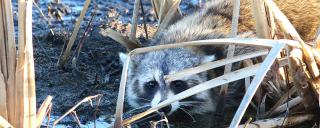 |
| Fact Sheet |
| Scientific Name |
Procyon lotor |
| Description |
Raccoons are known for their distinct black eye patches, giving them the appearance of wearing a mask, and their blackringed tail. Raccoons have slender legs contrasting with their large round body, pointed nose and round ears. When walking, the rear of their body is considerably higher than the front end. Raccoons have long, black-tipped hairs giving them a gray to black grizzled coloration. Their hair is darker on their backs and lighter on their bellies. |
Tracks |
Front–1-1/2" L, 2" W Rear– 3" L, 1-1/2" W |
| Total Length |
24-37 inches |
| Weight |
10-30 pounds |
| Habitat |
Raccoons are found throughout North Dakota and are capable of using a wide variety of habitats including wetlands, riparian areas, prairies and woodlots. Raccoons are commonly found in abandoned buildings and urban areas. |
| Breeding Season |
January-April |
| Gestation Period |
63 days |
| Litter Size |
1-7 (average 3-4) |
| Social Aspects |
Raccoons are primarily solitary except during mating and rearing of off spring. However, raccoons will tolerate other raccoons within their home ranges. |
| Status |
Raccoons are common throughout North Dakota and there is a year-round season. |
| Food Habits |
Raccoons are omnivorous and able to make do with almost anything as a food source. Major food items include insects, crayfi sh, frogs, fi sh, bird eggs, nuts, seeds (especially grains), acorns and berries. |
| Fun Facts |
Raccoons are capable of carrying several diseases that can be transmitted to people including leptospirosis, tularemia and rabies. The threat of rabies is the main reason why it is illegal to have a raccoon or a striped skunk as a "pet" in North Dakota. |


